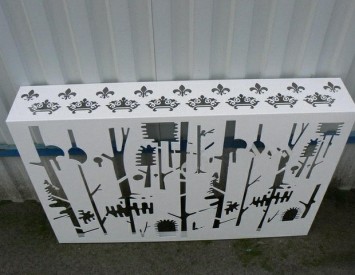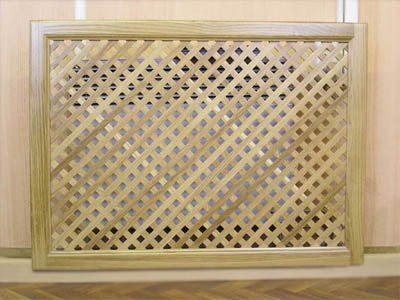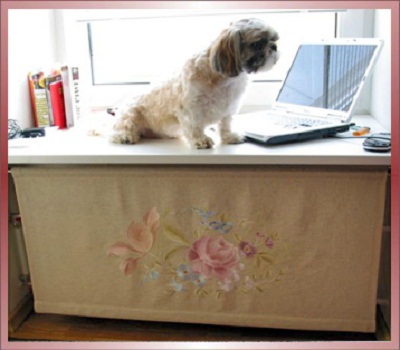Today, many, making repairs, leave old cast -iron heating radiators that hold heat well, but do not always fit into the modern interior. In this case, the screens for radiators will help to fix the situation.
Content
There are a great variety of variations on this topic. You can, having studied the range of construction stores, buy a screen for a radiator. And you can make it with your own hands, showing imagination, and thereby save money.
The basic requirements that should meet the screen for the heating radiator
- The screen should serve as an element of decor and combine with the environment.
- The screen material should have certain thermal conductive properties, i.e., it should pass the heat from the battery to the room.
What are decorative screens for radiators
- Metal.
- Wooden.
- Fabric.
- Others.
Metal screens for heating radiators
The continuous metal surface of the screen is heated from the battery, and then part of the heat is transported to the living room. However, part of the heat is lost. The best option is a screen with a carved or mesh metal surface. But, such decorative elements are better to purchase ready -made ones.
Wooden decorative screens for heating radiators
Wood has excellent thermal wire qualities. From it you can make a screen in the form of a decorative box, shield or even cabinets with doors. But here it will be better if the facade side is not continuous. Perforation in a whole piece of wood or a grate of wooden planks is a more acceptable solution that provides free access to heat flows from the register to the room.
Fabric decorative screens for radiators
This is an alternative option for a decorative screen, which is easy to build and personally. Moreover, this case is an unlimited space for the flight of fantasy. The canvas can be decorated with embroidery, application, painting, etc. The main thing is to choose the right fabric. It should be strong, but not too dense, so as not to prevent the outflow of warm air. Such a fabric screen is easy to pull on a wooden frame, which is then suspended on pre -prepared hooks. And you can simply pull the canvas from the windowsill to the floor, fixing the edges with a construction stapler, small cloves, etc. From the fabric, you can also sew an original cover in the form of funny little animals, which is enough just put on the battery. Look for patterns on the Internet. And, again, select the right fabric for such products, otherwise the battery will warm the cover, and not the air in your room.
Other screens for heating radiators
Actually, you can use the most diverse and most unexpected materials to create decorative screens. The basic principle is this: a frame is made from wooden planks (or some other), which can subsequently hang on the mounts prepared in advance in the wall above the radiator. And the facade side of the screen is made from the chosen material and attached to the frame. The easiest way is to make a lattice from some planks, ribbons, PVC stripes, chipboard and other materials. Here you can use the remains of repair work. If the material is aesthetic by itself, then such a lattice can be left without finishing. If the bar is not very beautiful, they can be painted in tone for surrounding objects or make multi -colored (this is a matter of taste and your preferences).
Making a screen for a heating radiator with your own hands (one of the options)
Materials and tools necessary for manufacturing
- DSP sheet (or trimming of the required size).
- Furniture finishing edge with a thermal adhesive layer on the back. The length of the edge required to create a lattice (L) is calculated by the formula L \u003d (A*B*1.3)/C, where A is the screen length, B is the screen width, C is the width of the edge.
- Metal corners and fitting screws (or other mounts).
- Furniture stapler with brackets (or small cloves with a hammer).
- Iron.
- Sharp knife.
- Sandpaper.
Manufacturing technology
- Make the necessary measurements and markings of the screen on the wall. Mark the places of future fasteners for placing the screen.
- Make a schematic drawing of the future product. There is no need to be a great drawing. It is enough to make a drawing that is understandable to you personally with the application of all the necessary sizes.
- Make 4 walls of the frame from chipboard. This operation, by the way, can be entrusted to specialists in the carpentry workshop. As an option, you can purchase ready -made parts of suitable sizes in such workshops or in construction stores.
- Combine them with each other using metal corners and solid screws (the connection method can be others).
- Make a grill from the edge, fixing its parts on the frame using a furniture stapler or small carnations. To make the openings of the grate, make preliminary markings on the frame or cut the workpiece of chipboard or cardboard.
- At the end of the weaving process, warm it up at a temperature of 150-200 ° C on the front side. At the same time, the heated glue will connect the gratings of the grate in the intersection, giving the structure more stiffness.
- Ground the end parts of the frame with the same edge. To do this, putting the edge to the end, reward it with an iron.
- Cut the protruding edges of the edge with a knife.
- Snipped the sharp edges with sandpaper.
- If the screen is designed for the location close between the windowsill and the floor, then insert it, and you can consider the task completed. If, it was originally implied by a suspended screen, then several more actions should be performed.
- Make a recess in places where it should dock with heating pipes. As a result, the screen is “dressed” on pipes using such peculiar grooves.
- In places above the radiator, where the position of the fasteners is marked, screw the metal corners on both sides.
- Bend the edges of the corners 10 mm up, thus constructing peculiar hooks on which the screen will be suspended.
All! Your decorative screen is ready. You can admire!















